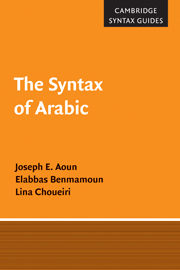Book contents
- Frontmatter
- Contents
- List of abbreviations
- 1 Issues in the syntax of Arabic
- 2 Clause structure in Arabic
- 3 The syntax of subjects
- 4 Sentential agreement
- 5 The syntax of sentential negation
- 6 Modes of wh-interrogation
- 7 Restrictive relatives
- 8 Clitic-left dislocation and focus constructions
- 9 The syntax of the Arabic left periphery
- References
- Index
1 - Issues in the syntax of Arabic
Published online by Cambridge University Press: 30 March 2010
- Frontmatter
- Contents
- List of abbreviations
- 1 Issues in the syntax of Arabic
- 2 Clause structure in Arabic
- 3 The syntax of subjects
- 4 Sentential agreement
- 5 The syntax of sentential negation
- 6 Modes of wh-interrogation
- 7 Restrictive relatives
- 8 Clitic-left dislocation and focus constructions
- 9 The syntax of the Arabic left periphery
- References
- Index
Summary
The Arabic language(s)
Arabic belongs to the Semitic branch of the Afro-Asiatic (Hamito-Semitic) family of languages, which includes languages like Aramaic, Ethiopian, South Arabian, Syriac, and Hebrew. A number of the languages in this group are spoken in the Middle East, the Arabian Peninsula, and Africa. It has been documented that Arabic spread with the Islamic conquests from the Arabian Peninsula and within a few decades, it spread over a wide territory across North Africa and the Middle East. Arabic is now spoken by more than 200 million speakers excluding bilingual speakers (Gordon 2005).
Although there is a debate about the history of Arabic (including that of the Standard variety and the spoken dialects) Arabic displays some of the typical characteristics of Semitic languages: root-pattern morphology, broken plurals in nouns, emphatic and glottalized consonants, and a verbal system with prefix and suffix conjugation.
The development of Arabic
Classical Arabic evolved from the standardization of the language of the Qur'an and poetry. This standardization became necessary at the time when Arabic became the language of an empire, with the Islamic expansion starting in the seventh century. In addition to Classical Arabic, there were regional spoken Arabic varieties. It is a matter of intense debate what the nature of the historical relation between Classical Arabic and the spoken dialects is (Owens 2007).
- Type
- Chapter
- Information
- The Syntax of Arabic , pp. 1 - 11Publisher: Cambridge University PressPrint publication year: 2009
- 2
- Cited by

